
|
|
| A new species
of the genus Bulbophyllum, B. gomesii Fraga (Orchidaceae), from the
Atlantic forest, in Espírito Santo, Brazil, is described and illustrated.
It is found in the Ecological Station of Mosteiro Zen Morro da Vargem, in
Ibiraçu province. It is also compared to Bulbophyllum longispicatum
Cogn., B. warmingianum Cogn., B. ipanemensis Hoehne and B.
involutum Borba, Semir & F. Barros. Key words: Bulbophyllum, Didactyle, Orchidaceae, Atlantic Forest, Brazil. |
|
|
| The genus Bulbophyllum
Thouars presents at about 1100 species, with a Pantropical distribution, with a greater number in the Paleotropical regions compared to the Neotropical (Dressler, 1993). The main revision to the Brazilian species has been done by Cogniaux (1902), who gathered 42 species, establishing 6 sections. Later, some synonymies and new species have been described, resulting in 54 species, discussed by Pabst & Dungs (1975, 1977), recently Borba et al. (1998) when describing a new species, suggested a revision to the genus in order to decrease the taxonomical problems to make possible a good determination of taxa. This work aims to describe and illustrates a new species of Bulbophyllum Thouars, comparing with similar species, coming from a certain region of the Atlantic Forest in the state of Espírito Santo, in Ecological Station Mosteiro Zen Morro da Vargem, lacked of botanical contributions. According to Thomaz & Monteiro (1997) the biological studies of the Atlantic Forest have the most absolute urgency due to the lack of well preserved areas and to the extreme vulnerability of this ecosystem as a whole, being the knowledge of the biodiversity the basic condition to the conservation measures of using, management and recuperation of the ecosystem. |
|
|
|
|
Bulbophyllum gomesii Fraga, sp. nov.
|
| Planta epiphytica, radicibus filiformibus, flexuosis, glabris, albenscentibus, rhyzomate repenti, flexuoso. Folium erectum, oblongo-ligulatum, coriaceum, apice acutum 2,6-6,2 cm longum, 1,8-2,2 cm latum, pseudobulbis 1-foliatis, inter se saepius 1,2-2,5 cm distantibus, erectis, ovoideis, 4-angulatis 1,0-2,2 cm longis, 1,0-1,5 cm latis. Inflorescentia erecta, levissime incurvata, 10-flora, 20,0-25,0 cm longa, ca. 1,0 mm lata, viridia, bracteis membranaceis, ovatis, acutis, 4,0-6,5 mm longis, 2,0-4,5 mm latis. Flores laxi, horizontaliter expanxi; ovarium lineariclavatum, obscure trigonum, leviter arcuatum, 4,0-5,0 mm longum et ca. 1,0 mm latum, viride. Sepala glabra, 3-nervulosa, viridia et maculis purpureis, dorsale lineari-lanceolata, acuminata, 1,0-1,1 cm longa, 2,0-3,0 mm lata, vena mediana usque ad apicem attingenti, venis lateralibus in dimidio sepali curvatis et venae medianae adnatis, lateralibus lineari-lanceolatis, paulo acuminatis, basi adnatis, 1,0-1,1 cm longis, 2,5-3,0 mm latis, vena mediana usque ad apicem attingenti, venis lateralibus paulo attenuatis in tertio superiore et venae medianae non adnatis. Petala lanceolata, glabra, apice acuta, margine integerrima, basin versus paulo attenuata et curvata, inferne alba et superne purpurea, 2,5-3,0 mm longa, ca. 1,0 mm lata, 1-nervata, vena apice non attingenti. Labellum basi incumbens, superne patulum, ellipticum, crasse carnosum, toto ciliatum, basi utrinque minutis auriculis lobulatis instructum, 0,8-1,0 cm longum, 2,5-3,0 mm latum, inferne purpureum, margine et apice albidis, in basi callo sulcatto, crasso, ca. 1,7 mm longo, lobulis basilaribus quadrangulari-rotundatis, erectis, ciliatis, ca. 1,0 mm longis et latis. Columna erecta, paulo incurvata, 2,0-2,1 mm longa, 0,6-0,7 mm lata, dentibus triangularibus, ca. 0,5 mm longis, apice utrinque brachiis filiformi-subulatis, erectis, leviter incurvis, 1,5-2,0 mm longis instructa, in basi pede 1,5-1,8 mm longo, 2-lobulis, quadrangularis, ca. 0,5 mm longis et latis. Anthera mucronata, papillosa, ca. 0,5 mm longa et lata. |
| HOLOTYPUS- Brazil,
Espírito Santo, Ibiraçu, Ecological Station Mosteiro Zen Morro da Vargem. Trilha do mirante 1, ca. 19º53'S/40º23'W,
300-470 m/s.m., Atlantic Forest, rupestrian vegetation sub-arbustiva em moitas, col.: J. M. L. Gomes 1145; H. Q. Boudet Fernandes & A. L. Martins, fl. 26/V/1990 (MBML 5956). ISOTYPUS (VIES5131). The specific binomial pays homage to José Manoel Lúcio Gomes, forest engineer of the Biology Department of the Federal University of the state of Espírito Santo who, together with his assistants, brought to the science this new species. To whom I own part of my academic formation, with his always precious remarks. The new species is close to Bulbophyllum longispicatum Cogn., B. warmingianum Cogn., B. ipanemensis Hoehne and B. involutum Borba, Semir & F. Barros, discussed respectively by Cogniaux (1902), Hoehne (1938) and Borba et al.(1998), belonged to a group of the section Didactyle Cogn., which bear multiflora inflorescence, column with arms and teeth, ciliate petals or denticulate at the margin, lobulate lip or auriculate at the base, disc with dense callosity and are vegetative very similar. The consistence of the lip is dense fleshy and the elliptic shape in Bulbophyllum gomesii Fraga approach this species to B. longispicatum Cogn., which presents a oblong lip with the same consistence. However the callus of the lip disc in this new species is furrowed, character not founded in B. longispicatum Cogn., but presents in the species B. warmingianum Cogn., B. ipanemensis Hoehne and B. involutum Borba, Semir & F. Barros. Although Bulbophyllum gomesii Fraga fits in the group, having the most part of similar characteristics, it will be easily recognized by presenting the foot of the column 2-lobulated and petals nor ciliate or denticulate. The foot of the column 2-lobulate is not found in any other species of the section while petals nor ciliate or denticulate are missing in all close related species but, according to Cogniaux (1902), common in the other group of species in the same section Dydactyle Cogn. |
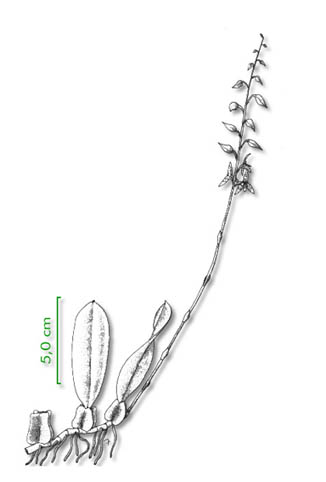 General aspect of the plant |
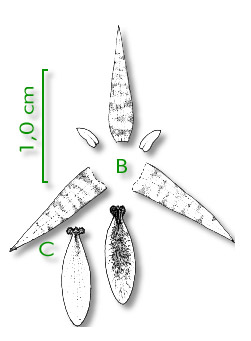 B- Dissect flower C- Lip dorsal view |
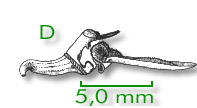 D- Column and lip, side view |
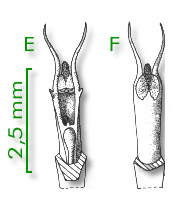 E- Column, ventral view F- Column, dorsal view |
|
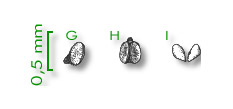 G- Anther, side view H- Anther, ventral view I- Polinia |
||
|
|
| To Dr. Jorge Fontella Pereira for the help in the Latin description and the revision of the manuscript. To Dorothy Sue Dunn de Araújo for the correction of the abstract. |
|
|
|
BORBA, E. L.; SEMIR,
J. & BARROS, F. |
Bulbophyllum involutum Borba, Semir & F. Barros (Orchidaceae), a new species from the Brazilian "Rupestrian Fields". Novon 8:225-229 | |
| __________ | ||
| DRESSLER,
R. L. 1993 |
Phylogeny and classication of the orchid family. Cambridge University Press, Cambridge, 314p. | |
| __________ | ||
| COGNIAUX,
A. 1902 |
Orchidaceae. In Martius, C. F. P.; Eichler, A. G. & Urban, I. (eds.) Flora Brasiliensis..., München, Wien, Leipzing, vol. 3, part. 5, p:1-664. | |
| __________ | ||
| HOEHNE,
F. C. 1938 |
Cincoenta e uma novas espécies da flora do Brasil e outras descrições e ilustrações. Arq. Bot. Est. S. Paulo 1 (1): 1-38. | |
| __________ | ||
| PABST,
G.F. J. & DUNGS, F. 1975 |
Orchidaceae Brasiliensis. vol. I. Kurt Schmersow, Hildesheim. 408 p. | |
| __________ | ||
| PABST,
G.F. J. & DUNGS, F. 1977 |
Orchidaceae Brasiliensis. vol. II. Kurt Schmersow, Hildesheim. 418 p. | |
| __________ | ||
| THOMAZ, L. D. & MONTEIRO, R. | Composição florística da Mata Atlântica de encosta da Estação Biológica de Santa Lúcia, município de Santa Tereza - ES. Bol. Mus. Biol. Mello Leitão (N.Sér.) 7:3-48. | |
| __________ |
| Cláudio
Nicoletti de Fraga, botanist, trustee of the alive collections of the the Botanical Garden of Rio de Janeiro, was born in Vitória, state of Espírito Santo. Graduated by the Federal University of Espírito Santo - UFES, he submitted his thesis to become master at the Federal University of Rio de Janeiro, discussing the orchids from his state. |
 |
|
Any kind of reproduction (print, digital or anyone other) of any type
of material of this site - texts, lay-out, photos, images and others
- is strictly forbidden without the previous written permission of the
authors.
Any solicitation or information should be done by the e-mail bo@sergioaraujo.com |
|
back
|